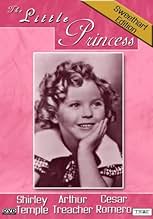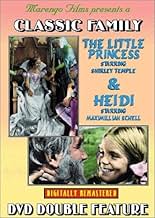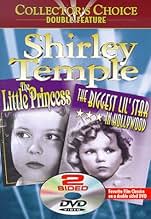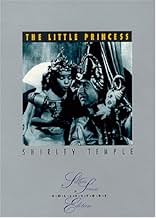Adicionar um enredo no seu idiomaA little girl is left by her father in an exclusive seminary for girls while he fights in the Second Boer War. Later, after he is presumed dead, she is forced to become a servant.A little girl is left by her father in an exclusive seminary for girls while he fights in the Second Boer War. Later, after he is presumed dead, she is forced to become a servant.A little girl is left by her father in an exclusive seminary for girls while he fights in the Second Boer War. Later, after he is presumed dead, she is forced to become a servant.
- Direção
- Roteiristas
- Artistas
- Prêmios
- 3 vitórias no total
- Bobbie
- (as Keith Kenneth)
- Direção
- Roteiristas
- Elenco e equipe completos
- Produção, bilheteria e muito mais no IMDbPro
Avaliações em destaque
Shirley Temple had her last great box-office triumph in this splendid Technicolor adaptation of the Frances Hodgson Burnett childhood classic. No longer a tiny tot - she turned eleven the year THE LITTLE PRINCESS was released - but still a little trooper, Shirley exhibits once again the tremendous charm & talent which made her Hollywood's top box office draw. With wrinkled brow & tremulous lip or bouncing curls & joyous smile, she adeptly displays just the right mood or mannerism to keep the focus of the audience's attention firmly grasped in her chubby fists.
The supporting players' roster is abundantly well cast: stalwart Ian Hunter appears as Shirley's soldier father - this very fine actor wisely uses his acting skills to keep from being completely upstaged by the mighty moppet; handsome Richard Greene & lovely Anita Louise play the riding master & teacher who befriend Shirley - their roles aren't terribly significant, but they fill them quite well.
Mary Nash is once again cast as Shirley's tormentor, this time playing the evil-spirited headmistress of an exclusive girls' seminary. This accomplished actress did not appear in many films, but she could generally be counted on to provide a vivid performance - notice the relish with which she essays her small part in the medieval fantasy sequence (`I know my rights, I know the law and what I say I saw, I saw!'). Long-legged, adenoidal Arthur Treacher plays her henpecked brother; he is a delight during his two romps with Shirley to the music hall ditty Knocked Em In The Old Kent Road.'
Cesar Romero quietly portrays an Indian servant in a small, but important, role; Miles Mander & E. E. Clive both appear as hardhearted, crusty old gentlemen - only one is regenerated by film's end. Sweet Beryl Mercer makes the most of her few moments as a stately, kindhearted Queen Victoria - while Eily Malyon is a true fright as the school's slatternly cook. Marcia Mae Jones participates in one of the film's most memorable moments, when, as a particularly vile teenager, she receives a face full of fireplace ashes, courtesy of sweet Shirley.
Special attention should be given to ten-year-old South African Sybil Jason, who plays the wistful waifish charmaid who idolizes Shirley. In her American film debut, Warner's LITTLE BIG SHOT (1935), she proved wonderfully winsome & winning, but the storm of attention surrounding Miss Temple (exactly 19 months older than Miss Jason) tends, at this remove, to swamp the boats of the other female child stars of the period. However, delightful Sybil deserves to be remembered & appreciated for her own accomplishments.
The Stolen Kiss, a lavish fantasy dream sequence, provides a welcome few minutes change of pace for Temple, Nash, Louise, Greene, Treacher & Romero.
This is a lavish technicolor delight with Shirley Temple at 12 doing an expert job as Sara, the little miss who has to bear the indignities of a boarding school once her father has been declared dead in the Boer war. The harsh mistress (Mary Nash) has her stripped of all privileges and makes her live in the attic while becoming a servant in the very household where she was once called "the little princess" by the other girls. There are departures from the novel since the script is given a "Shirley Temple formula" to ensure its success as the right vehicle for her at that time. But the addition of a dream sequence does no discernible harm, nor is the brief song-and-dance with Arthur Treacher to "The Old Kent Road" much of a distraction.
It succeeds in being a heart-warming tale of a girl's courage and determination when it seems that there is no hope of finding her father alive. The ending with Queen Victoria giving Shirley an approving nod, is an added delight. One of Shirley's best performances with a wonderful cast of supporting players: Richard Greene, Anita Louise, Mary Nash, Sybil Jason, Arthur Treacher and Cesar Romero all doing expert work.
When word is brought to the school that the father, who adored his Sarah (Temple), has been killed and the child is left penniless, poor Sarah is shut up in the attic and made to work in the kitchen. Move over Cinderella.
Sarah never gives up hope that her dad (Ian Hunter) is living and she searches feverishly for him.
When a Indian mystery man (Cesar Romero) makes her room beautiful during a ballet sequence, Sarah is suspected of stealing.
Mary Nash is the wicked headmistress and acts in the same way as Margaret Hamilton in "The Wizard of Oz." Richard Green and Anita Louise play lovers, who are discharged from the school, by Nash for loving each other.
The ending is wonderful when Sarah finds her dad with the help no less of Queen Victoria (Beryl Mercer).
Enjoyable tale for children and adults alike.
Set in London in the year 1899, Sara (Shirley Temple) is the daughter of her widowed father, Captain Crewe (Ian Hunter), who leaves her in a boarding school under the care of Miss Amanda Mirchin (Mary Nash) and her brother, Bertie (Arthur Treacher), a former music hall performer, before he goes off to the Boer War. Because Crewe is a well known figure and man of wealth, Sara is given the royalty treatment, as if she were "a little princess," causing jealously amongst one of the other girls, Lavinia (Marcia Mae Jones), who doesn't want to lose her place with Miss Mirchin. After Miss Mirchin receives news from Mr. Babbows (E.E. Clive) that Captain Crewe has been killed in the war, leaving daughter Sara penniless, she, at first, decides to put Sara and her belongings into the street, but Babbows advises her that this would not look good for her or the school. So the only other alternative is to place Sara from her luxurious room into a cold attic, taking her expensive clothing and auctioning it off to pay for her lodging, leaving Sara with only paupers' clothes to wear. In order to earn her keep, Sara must work long hard hours in the kitchen along with another girl, Becky (Sybil Jason), who befriends her. Being treated harshly, Sara becomes a hard and bitter child who tries to be a good soldier as her father had wanted her to be, but finds she's unable to do it, being at times both hungry and cold. Not wanting to believe her father is dead, Sara braves the streets of London at night in hope to one day find him amongst the wounded in the military hospital.
Also in support in THE LITTLE PRINCESS are Richard Greene and Anita Louise as the young romantic couple, with Louise as Miss Rose, an employee of the boarding school who loses her position for secretly meeting with Sir Geoffrey Hamilton (Greene) against the wishes of Miss Minchin; Cesar Romero as Ram Dass, an Arab servant to Lord Wickham (Miles Mander), Sir Geoffrey's grandfather; Eily Malyon as an unsympathetic boarding school cook; and Beryl Mercer as Queen Victoria, among others.
Aside from the heavy handled dramatics that resembles a dark Charles Dickens novel, THE LITTLE PRINCESS does take time for some song and dance, including "Down By the Old Kent Road" (by Arthur Chevalier and Charles Ingle) as sung and danced by Shirley Temple and Arthur Treacher; and as with Temple's earlier classic, HEIDI, there's a musical dream sequence, this one titled "Fantasy" by Walter Bullock and Samuel Pokrass.
As with HEIDI, THE LITTLE PRINCESS is prestigious Temple production. It also reunites her with her HEIDI co-stars, Mary Nash, Arthur Treacher and Marcia Mae Jones. And also like HEIDI, THE LITTLE PRINCESS gives the impression of a hurried conclusion.
Mary Nash gives a standout performance with her female interpretation of Mr. Murdstone from Dickens' novel, David COPPERFIELD, with Treacher a likable Micawber character from that very same novel. Temple and Treacher have fine screen chemistry, with this being their fourth and final collaboration together. The 1899 London period setting is wonderfully captured along with its lavish crisp Technicolor. Sybil Jason, a promising young child actress of Warner Brothers (1935-38), who didn't rise above the rank of Temple, is quite memorable playing the cockney orphan, Becky. Her performance is unlike anything she has done before, but sadly, after one more film, THE BLUE BIRD (1940), which also starred Temple, Jason's career would come to an end.
Unlike the other Shirley Temple movies of the 1930s, THE LITTLE PRINCESS became a public domain video title, being distributed through various video companies through the years (1980s and 1990s), and like the Christmas classic, IT'S A WONDERFUL LIFE (1946), which also fell victim to public domain, THE LITTLE PRINCESS became frequently shown on numerous television stations at any given time. The 1989 CBS Fox Home Video presentation of THE LITTLE PRINCESS does present this film with the best Technicolor print available, outdoing some others with duller looking copies. THE LITTLE PRINCESS was formerly presented on cable television's American Movie Classics from 1996 to 2001, and occasionally airs on Turner Classic Movies and on the Fox Movie Channel. Wherever THE LITTLE PRINCESS is found, it makes good family viewing.
One final note: the Frances Hodgeson Burnett classic included a 1917 silent film version starring Mary Pickford, and a 1995 remake with Eleanor Bron, both titled A LITTLE PRINCESS. But whenever THE LITTLE PRINCESS is mentioned, it'll be no doubt that the Shirley Temple version will be the one that comes to mind. (****)
For the most part, it follows the familiar story, though often embellished, particularly towards the end. The story and Temple's characterization give it a rather different feel from, for example, the silent version that starred Mary Pickford. Here, Temple projects much of her own persona, with her best moments coming with Arthur Treacher, who plays the easygoing brother of the stern headmistress. The character of Becky is still significant, but Temple does not ever have the rapport with her that Pickford and Zasu Pitts had in the earlier version.
As a result, it's a bit uneven overall, but for those who enjoy this kind of story, it's still worthwhile. The public domain print makes it somewhat difficult to evaluate the production end, although it clearly contained plenty of detail and color. It's a decent if unexceptional feature whose high points are usually worth waiting for.
Você sabia?
- CuriosidadesIn the scene where a parrot flies into Sara's room off of Ram Dass' (Cesar Romero) shoulder, originally a small monkey was to be used. However, the monkey did not seem to like Shirley Temple and kept trying to bite her, so it was replaced by a parrot.
- Erros de gravaçãoThere are many references in the film to receiving "mail" and "mailing" letters. The British terminology is always receiving "post" and "posting" letters.
- Citações
Sara Crewe: Daddy?
Captain Crewe: Sara...
Sara Crewe: Daddy! Oh, Daddy! It is you! I found you! I found you! They said you were dead, but I knew you weren't! I knew you'd come back! Oh, Daddy, hold me, hold me close. You won't ever go away again, will you? Will you, Daddy? What's the matter, Daddy? Why don't you talk to me?
Captain Crewe: Sara...
Sara Crewe: Don't you know me, Daddy? I'm Sara! I'm Sara!
Captain Crewe: Sara... Where is my daughter...
Sara Crewe: Oh, Daddy! Something's happened to you! Mr. Bertie! Mr. Bertie! Oh, Daddy, you've got to know me! Look at me! Look at me! Oh, Daddy...
[sobs]
Captain Crewe: You musn't cry. You musn't cry. We must be good soldiers, you know.
Sara Crewe: But, I have been a good soldier, Daddy! And you don't know me!
Captain Crewe: My little Sara never cries...
Sara Crewe: But, I'm Sara! I'm Sara!
Captain Crewe: Sara... Sara! My little... My darling...
Sara Crewe: Oh, Daddy! You know me! You know me!
Captain Crewe: Sara, my darling! My baby Sara! Sara! Poor Sara, darling!
- ConexõesEdited into Muppet Babies: Muppets Not Included (1988)
- Trilhas sonorasThe Fantasy
Music by Samuel Pokrass
Words by Walter Bullock
Performed by Shirley Temple, Arthur Treacher, Mary Nash,
Cesar Romero, Anita Louise, Richard Greene, and unidentified extras.
Danced by Temple with unidentified ballerinas
Principais escolhas
Detalhes
Bilheteria
- Orçamento
- US$ 1.000.000 (estimativa)
- Tempo de duração1 hora 33 minutos
- Proporção
- 1.37 : 1
Contribua para esta página







































